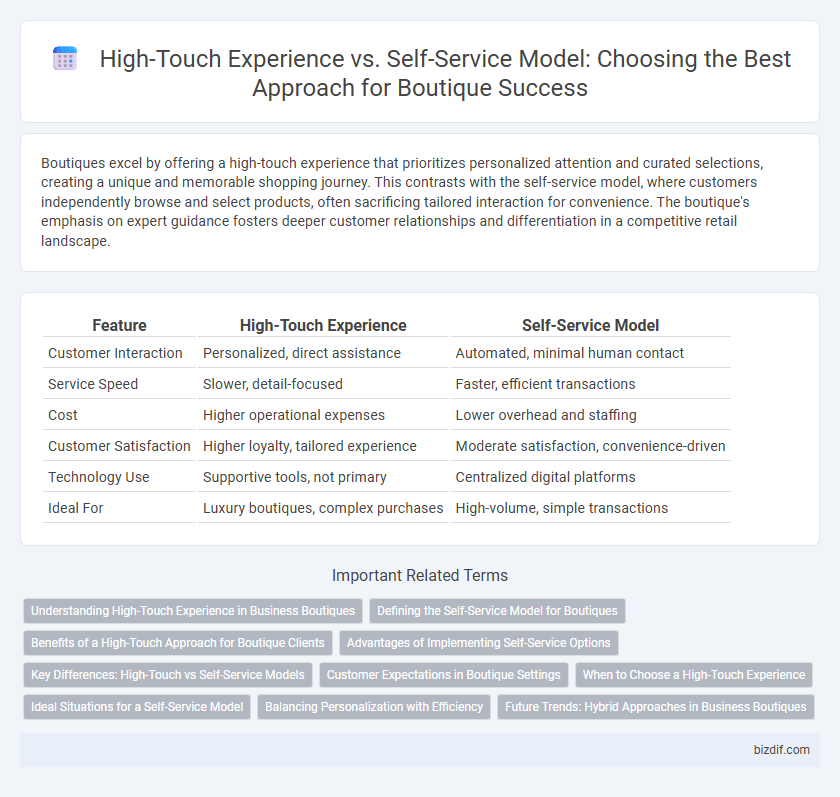Boutiques excel by offering a high-touch experience that prioritizes personalized attention and curated selections, creating a unique and memorable shopping journey. This contrasts with the self-service model, where customers independently browse and select products, often sacrificing tailored interaction for convenience. The boutique's emphasis on expert guidance fosters deeper customer relationships and differentiation in a competitive retail landscape.
Table of Comparison
| Feature | High-Touch Experience | Self-Service Model |
|---|---|---|
| Customer Interaction | Personalized, direct assistance | Automated, minimal human contact |
| Service Speed | Slower, detail-focused | Faster, efficient transactions |
| Cost | Higher operational expenses | Lower overhead and staffing |
| Customer Satisfaction | Higher loyalty, tailored experience | Moderate satisfaction, convenience-driven |
| Technology Use | Supportive tools, not primary | Centralized digital platforms |
| Ideal For | Luxury boutiques, complex purchases | High-volume, simple transactions |
Understanding High-Touch Experience in Business Boutiques
A high-touch experience in business boutiques emphasizes personalized customer interactions, tailored services, and in-depth product knowledge delivered by skilled staff, creating a unique and memorable shopping environment. This approach contrasts with the self-service model, where customers independently navigate their purchases with minimal assistance, focusing on speed and convenience. Understanding the high-touch experience is crucial for boutiques aiming to build strong client relationships, enhance brand loyalty, and differentiate themselves in competitive retail markets.
Defining the Self-Service Model for Boutiques
The self-service model for boutiques empowers customers to independently explore and select products through digital platforms or in-store kiosks, minimizing the need for direct staff interaction. This approach leverages technology such as mobile apps, interactive displays, and augmented reality to enhance the shopping experience while maintaining boutique exclusivity. By integrating personalized recommendations and seamless checkout processes, boutiques can offer convenience without compromising their curated brand identity.
Benefits of a High-Touch Approach for Boutique Clients
Boutique clients benefit from a high-touch approach through personalized attention that tailors products and services to their specific needs, enhancing customer satisfaction and loyalty. This method fosters deeper relationships by providing expert guidance, exclusive offerings, and hands-on support that self-service models often cannot match. High-touch interactions drive higher value perceptions, encouraging repeat business and strong brand advocacy within niche markets.
Advantages of Implementing Self-Service Options
Implementing self-service options in boutiques enhances customer convenience by allowing shoppers to browse, customize, and purchase products at their own pace, reducing wait times and increasing satisfaction. This model optimizes operational efficiency by decreasing the need for extensive staff assistance, thereby lowering labor costs and improving scalability. Data shows that integrating digital self-service kiosks and mobile apps boosts sales conversion rates by up to 30%, evidencing stronger customer engagement and streamlined shopping experiences.
Key Differences: High-Touch vs Self-Service Models
High-touch experiences in boutiques emphasize personalized customer interactions and tailored service, often involving direct assistance from knowledgeable staff to enhance satisfaction and loyalty. In contrast, self-service models prioritize efficiency and convenience by allowing customers to independently browse and make purchases through digital platforms or in-store kiosks, reducing the need for staff involvement. Key differences include the level of human engagement, customization potential, and overall customer journey control, where high-touch offers immersive, relationship-driven shopping and self-service facilitates faster, autonomous transactions.
Customer Expectations in Boutique Settings
Customers in boutique settings increasingly expect a high-touch experience characterized by personalized attention, expert guidance, and tailored service that enhances their shopping journey. The self-service model, while efficient, often falls short in meeting these expectations, as boutique clientele value human interaction and bespoke recommendations. Meeting and exceeding these customer expectations requires boutiques to prioritize intimate, customized experiences that foster loyalty and satisfaction.
When to Choose a High-Touch Experience
A high-touch experience is ideal when catering to discerning clients seeking personalized service, complex product customization, or expert guidance that enhances satisfaction and loyalty. Boutique businesses should prioritize this model during luxury purchases, bespoke services, or when building long-term client relationships. This approach fosters trust and differentiates the brand in competitive markets where emotional connection and attention to detail drive customer decisions.
Ideal Situations for a Self-Service Model
A self-service model thrives in boutique environments with tech-savvy customers who prefer quick, independent browsing and purchasing without intensive staff interaction. Ideal situations include high-traffic locations where reducing wait times boosts customer satisfaction and sales efficiency. Retailers benefit when inventory is standardized and digital kiosks or apps provide detailed product information, allowing shoppers to make informed decisions autonomously.
Balancing Personalization with Efficiency
Boutiques excel by offering a high-touch experience that delivers personalized attention, tailored product recommendations, and exclusive services, fostering strong customer relationships. In contrast, the self-service model emphasizes efficiency through streamlined processes and customer autonomy, reducing wait times and operational costs. Balancing these approaches involves leveraging technology to enhance personalization while maintaining quick, convenient access, creating a seamless shopping journey that meets diverse consumer preferences.
Future Trends: Hybrid Approaches in Business Boutiques
Future business boutiques are increasingly adopting hybrid approaches that blend high-touch experiences with efficient self-service models to meet diverse customer preferences. Integrating personalized in-store interactions with digital platforms enhances customer engagement and streamlines operations. Data-driven insights and AI technologies play a pivotal role in optimizing these hybrid models, ensuring scalability without sacrificing the boutique's signature personalized service.
High-Touch Experience vs Self-Service Model Infographic

 bizdif.com
bizdif.com